You're clearly misunderstanding the roles of the editor and the renderer. A editor allows a user to edit the state of a cell, a renderer renders the state of the cell.
They do this through the use of the TableModel. Start by having a look at Concepts: Editors and Renderers and Using Other Editors for more details.
To start with the things you're doing wrong...
signalTable.setModel(new DefaultTableModel(
new Object[][] {
{"AAA", "A_SIGNAL", null, null, null, null, null, null, null, null, "Example", Boolean.TRUE},
},
new String[] {
"ID", "Message Identifier", "0", "1", "2", "3", "4", "5", "6", "7", "Description", ""
}
) {
Class[] columnTypes = new Class[] {
String.class, String.class, JButton.class, JButton.class, JButton.class, JButton.class, JButton.class, JButton.class, JButton.class, JButton.class, String.class, Boolean.class
};
public Class getColumnClass(int columnIndex) {
return columnTypes[columnIndex];
}
});
The cell values for the "color" cells should true or false (they can be any other "on"/"off" value you want, so long as the editor and renderer know how to deal with them, but for this example, I'm using booleans)
The columnTypes for these cells should also be Boolean.class
signalTable.setModel(new DefaultTableModel(
new Object[][]{
{"AAA", "A_SIGNAL", false, false, false, false, false, false, false, false, "Example", Boolean.TRUE},},
new String[]{
"ID", "Message Identifier", "0", "1", "2", "3", "4", "5", "6", "7", "Description", ""
}
) {
Class[] columnTypes = new Class[]{
String.class, String.class, Boolean.class, Boolean.class, Boolean.class, Boolean.class, Boolean.class, Boolean.class, Boolean.class, Boolean.class, String.class, Boolean.class
};
public Class getColumnClass(int columnIndex) {
return columnTypes[columnIndex];
}
});
So, now, if you did nothing else, you would have JCheckBoxs in those cells, but that's not what we want.
public class ButtonEditor extends DefaultCellEditor
{
protected JButton button;
public ButtonEditor(JCheckBox checkBox)
{
super(checkBox);
button = new JButton();
button.setOpaque(true);
button.addActionListener(new ActionListener()
{
public void actionPerformed(ActionEvent e)
{
button.setBackground(Color.GREEN);
button.repaint();
}
});
}
public Component getTableCellEditorComponent(JTable table, Object value,
boolean isSelected, int row, int column)
{
return button;
}
}
Here, you are ignoring the JCheckBox which is passed to your editor and creating your own, but there are two problems with this. The DefaultCellEditor is deriving the cells value from the JCheckBox, not some other state (so it's always false) and you never configure the button to represent the current state of the cell when it's requested.
Because I don't want to deal with other components, I'm going to do something a little different.
public class ButtonEditor extends AbstractCellEditor implements TableCellEditor {
private JLabel editor;
public ButtonEditor() {
editor = new JLabel();
editor.setBackground(Color.GREEN);
editor.addMouseListener(new MouseAdapter() {
@Override
public void mouseClicked(MouseEvent e) {
editor.setOpaque(!editor.isOpaque());
stopCellEditing();
}
});
}
@Override
public Component getTableCellEditorComponent(JTable table, Object value, boolean isSelected, int row, int column) {
if (value instanceof Boolean) {
boolean result = (boolean) value;
editor.setOpaque(!result);
}
return editor;
}
@Override
public Object getCellEditorValue() {
return editor.isOpaque();
}
@Override
public boolean isCellEditable(EventObject e) {
return true;
}
}
This is just a JLabel which when clicked, will switch it's opaque state. We also use this state to determine the cell value when the editor is "stopped"
public class TableColorRenderer extends JLabel implements TableCellRenderer
{
@Override
public Component getTableCellRendererComponent(JTable table, Object value, boolean isSelected, boolean hasFocus, int row, int column)
{
return this;
}
}
Well, frankly, that's a bit useless, it never does anything with the value of cell
public class TableColorRenderer extends JLabel implements TableCellRenderer {
public TableColorRenderer() {
setBackground(Color.GREEN);
}
@Override
public Component getTableCellRendererComponent(JTable table, Object value, boolean isSelected, boolean hasFocus, int row, int column) {
if (value instanceof Boolean) {
boolean result = (boolean) value;
setOpaque(result);
} else {
setOpaque(false);
}
return this;
}
}
Again, pretty simple. We check the value of the cell (as passed to us) and change the opaque state accordingly
And because no one ever believes me, a runnable example

import java.awt.BorderLayout;
import java.awt.Color;
import java.awt.Component;
import java.awt.EventQueue;
import java.awt.event.MouseAdapter;
import java.awt.event.MouseEvent;
import java.util.EventObject;
import javax.swing.AbstractCellEditor;
import javax.swing.JFrame;
import javax.swing.JLabel;
import javax.swing.JPanel;
import javax.swing.JScrollPane;
import javax.swing.JTable;
import javax.swing.UIManager;
import javax.swing.UnsupportedLookAndFeelException;
import javax.swing.table.DefaultTableModel;
import javax.swing.table.TableCellEditor;
import javax.swing.table.TableCellRenderer;
public class Example {
public static void main(String[] args) {
new Example();
}
public Example() {
EventQueue.invokeLater(new Runnable() {
@Override
public void run() {
try {
UIManager.setLookAndFeel(UIManager.getSystemLookAndFeelClassName());
} catch (ClassNotFoundException | InstantiationException | IllegalAccessException | UnsupportedLookAndFeelException ex) {
ex.printStackTrace();
}
JFrame frame = new JFrame("Testing");
frame.setDefaultCloseOperation(JFrame.EXIT_ON_CLOSE);
frame.add(new TestPane());
frame.pack();
frame.setLocationRelativeTo(null);
frame.setVisible(true);
}
});
}
public class TestPane extends JPanel {
private final JTable signalTable;
public TestPane() {
signalTable = new JTable();
signalTable.setModel(new DefaultTableModel(
new Object[][]{
{"AAA", "A_SIGNAL", false, false, false, false, false, false, false, false, "Example", Boolean.TRUE},},
new String[]{
"ID", "Message Identifier", "0", "1", "2", "3", "4", "5", "6", "7", "Description", ""
}
) {
Class[] columnTypes = new Class[]{
String.class, String.class, Boolean.class, Boolean.class, Boolean.class, Boolean.class, Boolean.class, Boolean.class, Boolean.class, Boolean.class, String.class, Boolean.class
};
public Class getColumnClass(int columnIndex) {
return columnTypes[columnIndex];
}
});
TableColorRenderer renderer = new TableColorRenderer();
signalTable.getColumn("0").setCellRenderer(renderer);
signalTable.getColumn("1").setCellRenderer(renderer);
signalTable.getColumn("2").setCellRenderer(renderer);
signalTable.getColumn("3").setCellRenderer(renderer);
signalTable.getColumn("4").setCellRenderer(renderer);
signalTable.getColumn("5").setCellRenderer(renderer);
signalTable.getColumn("6").setCellRenderer(renderer);
signalTable.getColumn("7").setCellRenderer(renderer);
signalTable.getColumn("0").setCellEditor(new ButtonEditor());
signalTable.getColumn("1").setCellEditor(new ButtonEditor());
signalTable.getColumn("2").setCellEditor(new ButtonEditor());
signalTable.getColumn("3").setCellEditor(new ButtonEditor());
signalTable.getColumn("4").setCellEditor(new ButtonEditor());
signalTable.getColumn("5").setCellEditor(new ButtonEditor());
signalTable.getColumn("6").setCellEditor(new ButtonEditor());
signalTable.getColumn("7").setCellEditor(new ButtonEditor());
setLayout(new BorderLayout());
add(new JScrollPane(signalTable));
}
}
public class ButtonEditor extends AbstractCellEditor implements TableCellEditor {
private JLabel editor;
public ButtonEditor() {
editor = new JLabel();
editor.setBackground(Color.GREEN);
editor.addMouseListener(new MouseAdapter() {
@Override
public void mouseClicked(MouseEvent e) {
editor.setOpaque(!editor.isOpaque());
stopCellEditing();
}
});
}
@Override
public Component getTableCellEditorComponent(JTable table, Object value, boolean isSelected, int row, int column) {
if (value instanceof Boolean) {
boolean result = (boolean) value;
editor.setOpaque(!result);
}
return editor;
}
@Override
public Object getCellEditorValue() {
return editor.isOpaque();
}
@Override
public boolean isCellEditable(EventObject e) {
return true;
}
}
public class TableColorRenderer extends JLabel implements TableCellRenderer {
public TableColorRenderer() {
setBackground(Color.GREEN);
}
@Override
public Component getTableCellRendererComponent(JTable table, Object value, boolean isSelected, boolean hasFocus, int row, int column) {
if (value instanceof Boolean) {
boolean result = (boolean) value;
setOpaque(result);
}
return this;
}
}
}



